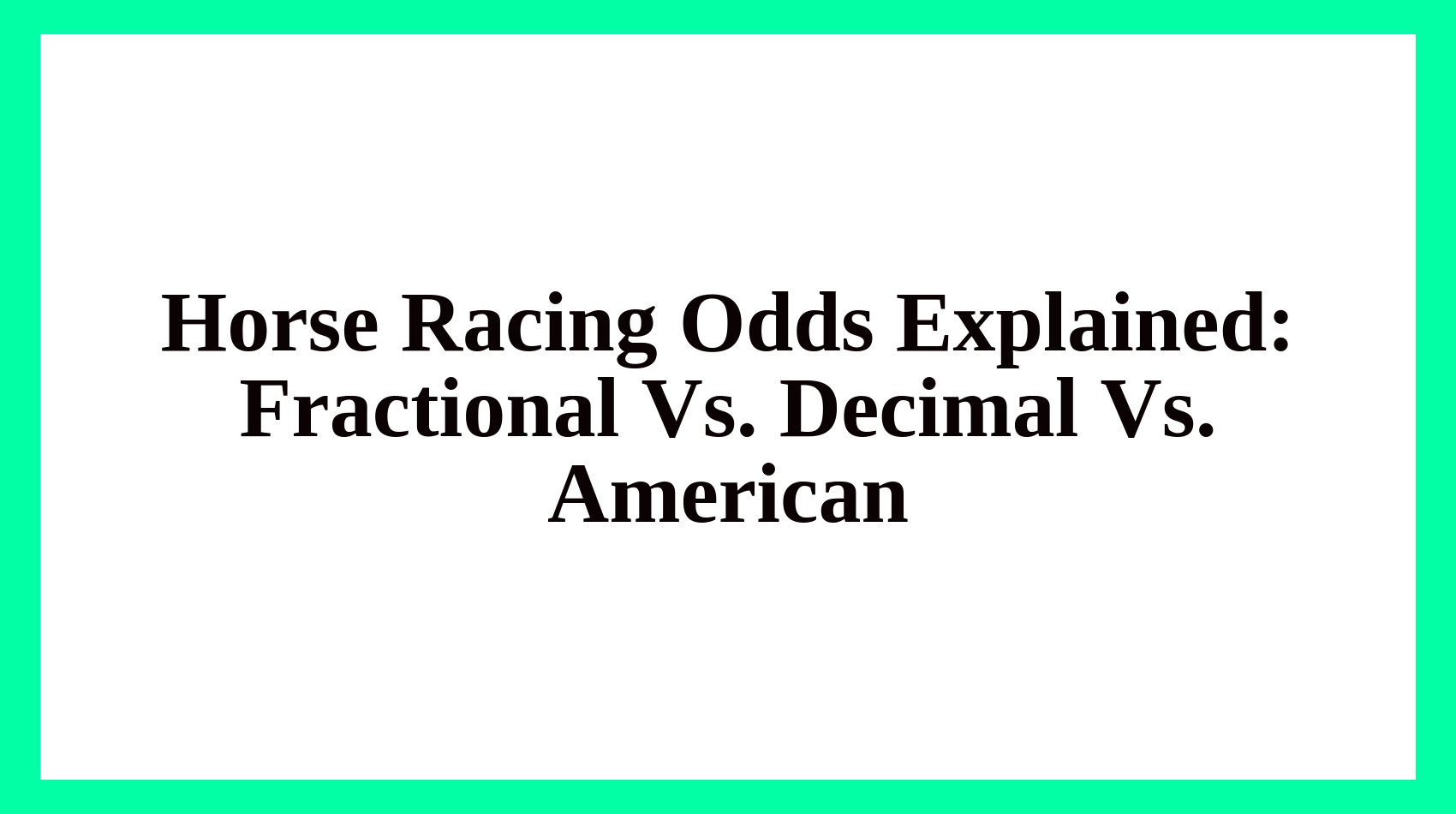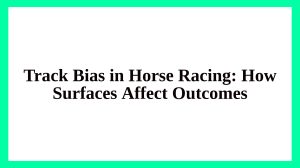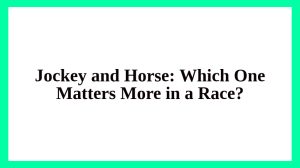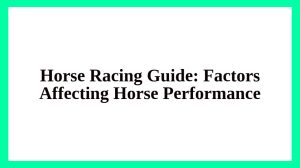Introduction: Why Understanding Horse Racing Odds Matters
Horse racing may look simple—pick a horse, place a bet, and watch it run—but what separates casual fans from smart bettors is one word: odds.
Odds show how much you can win and how likely your horse is to succeed.
However, the numbers can look confusing because odds are displayed in different formats—Fractional, Decimal, and American. Each tells the same story in a different language.
If you want to enjoy betting on Japan’s major races like the Tokyo Yushun (Japanese Derby) or online races abroad, understanding how odds work is the foundation of smart wagering.
This guide breaks down every format, explains how to read them, and shows which one gives you the clearest picture of value and probability.
If you’re new to the sport, start with our beginner guide first:
👉 What Is Horse Racing?
Definition and Purpose
In horse racing, odds are the numerical representation of probability and payout. They tell you two things every bettor needs to know:
- The likelihood of a horse winning the race, and
- The amount of money you’ll receive if your horse wins.
Odds are calculated using mathematical models, historical data, and real-time betting activity. Bookmakers or racing systems (like the Japan Racing Association’s pari-mutuel system) continuously adjust these odds based on how much money is placed on each horse.
When more people bet on a horse, its odds decrease because it’s now seen as more likely to win.
When fewer people bet on a horse, its odds increase, reflecting lower expectations and higher potential rewards.
In short:
- Low odds = favorite → higher chance of winning, smaller payout.
- High odds = underdog → lower chance of winning, bigger payout.
Why Odds Exist
Odds are the foundation of horse racing betting — they connect probability, excitement, and fairness. Without odds, there would be no way to balance potential winnings with risk.
Here’s why odds are essential:
- They determine payouts: Odds directly affect how much you win for every yen, dollar, or pound you bet.
- They reflect the horse’s perceived ability: Factors include recent race results, jockey performance, track surface, and even weather.
- They balance the market: Odds adjust automatically to prevent all money from going on a single horse.
- They motivate betting diversity: Bettors are encouraged to explore multiple horses since different odds offer different risk/reward ratios.
For example:
If Horse A is priced at 2/1 (fractional) or 3.00 (decimal), it’s likely one of the favorites — reliable but not highly profitable.
If Horse B is at 20/1 (fractional) or 21.00 (decimal), it’s a long shot — unlikely to win, but capable of delivering huge returns if it does.
This structure ensures every race attracts balanced wagering, keeping the competition fair and engaging.
How Odds Are Calculated in Horse Racing
Odds in horse racing are not fixed guesses — they evolve dynamically before the race starts. They are determined in two ways:
1. Fixed-Odds Betting (Bookmaker System)
- Common in Western markets and online betting platforms.
- Bookmakers set the initial prices for each horse based on form, speed, trainer, jockey, and public sentiment.
- Once you place a bet, your odds are locked — even if they change before the race begins.
2. Pari-Mutuel Betting (Pool System)
- Used in Japan, Hong Kong, and many other regions.
- All bets go into a shared pool.
- After deducting a small commission (called the “takeout”), the remaining money is divided among winning bettors.
- The odds keep fluctuating until the betting window closes.
This system ensures that your payout depends on how many others backed the same horse, not on a fixed bookmaker estimate.
The Relationship Between Odds and Probability
The core principle behind odds is implied probability — a mathematical estimate of how likely a horse is to win.
To understand this, think of odds as a percentage.
For example:
- 2/1 (fractional) → 1 in 3 chance to win → ~33.3% probability
- 5/1 (fractional) → 1 in 6 chance → ~16.7% probability
- 10/1 (fractional) → 1 in 11 chance → ~9.1% probability
Even though these percentages are only theoretical (since real outcomes depend on performance), they give bettors a realistic expectation of risk.
Three Main Types of Horse Racing Odds
Horse racing odds appear in three main formats, depending on the country or betting platform.
Each format represents the same underlying concept — how much you’ll win compared to your stake — but uses different notations.
| Format | Used In | Example | How It Works |
| Fractional Odds | United Kingdom & Ireland | 5/1 | You win ¥5 for every ¥1 you bet (plus your stake). |
| Decimal Odds | Japan, Europe, Australia | 6.00 | You receive ¥6 total for every ¥1 bet (includes your stake). |
| American Odds | United States | +500 or –200 | +500 means you win ¥500 for a ¥100 bet; –200 means you must bet ¥200 to win ¥100. |
For instance:
If you see 5/1, 6.00, or +500, they all represent the same payout ratio — a horse with roughly 16.7% winning probability.
This equivalence is useful when comparing odds across international betting websites or Japanese online sportsbooks that display mixed formats.
Practical Example of How Odds Work in a Race
Let’s imagine a 10-horse race at Tokyo Racecourse:
| Horse Name | Odds (Decimal) | Odds (Fractional) | Implied Probability |
| Golden Sakura | 2.50 | 3/2 | 40% |
| Rising Arrow | 5.00 | 4/1 | 20% |
| Midnight Spirit | 8.00 | 7/1 | 12.5% |
| Storm Harbor | 12.00 | 11/1 | 8.3% |
| Blue Horizon | 21.00 | 20/1 | 4.7% |
If you bet ¥1,000 on Golden Sakura (2.50) and it wins, you’ll receive ¥2,500 total (¥1,500 profit + your ¥1,000 stake).
If you bet the same amount on Blue Horizon (21.00) and it wins, you’ll receive ¥21,000 — but the chance of that happening is much smaller.
This balance between risk and reward is the heart of horse racing betting strategy.
Key Takeaways
- Horse racing odds express both probability and potential payout.
- They are influenced by form, betting activity, and market movement.
- There are three formats — Fractional, Decimal, and American — all representing the same math in different styles.
- Learning to interpret odds helps you find value bets, manage risk, and make informed decisions — essential for consistent success at the racetrack or online.
1. Fractional Odds Explained
Understanding Fractional Odds
Fractional odds—like 5/1, 3/2, or 10/11—tell you how much profit you make for every unit staked.
- 5/1 (read as “five-to-one”)
→ You win ¥5 for every ¥1 you bet + your original ¥1 stake. - 10/11 (read as “ten-to-eleven”)
→ You win ¥10 for every ¥11 staked—slightly less than doubling your money.
Formula and Example
Profit = Stake × (Fraction)
Total Return = Stake + Profit
Example:
If you bet ¥1,000 at 5/1
→ Profit = 1,000 × 5 = ¥5,000
→ Total Return = ¥6,000
Advantages of Fractional Odds
- Classic and widely used in UK racing.
- Easy for experienced bettors to estimate profit at a glance.
Disadvantages
- Harder for beginners to understand the implied probability.
- Converting to payout percentages requires calculation.
Implied Probability Formula
Probability(%)=DenominatorDenominator+Numerator×100Probability (\%) = \frac{Denominator}{Denominator + Numerator} × 100Probability(%)=Denominator+NumeratorDenominator×100
Example: For 5/1
Probability=11+5×100=16.7%Probability = \frac{1}{1 + 5} × 100 = 16.7 \%Probability=1+51×100=16.7%
So, a horse at 5/1 has a 16.7 % chance of winning based on odds.
2. Decimal Odds Explained
Understanding Decimal Odds
Decimal odds are the most common format in Japan and online betting sites worldwide.
They show the total return (including stake) for each unit bet.
- 2.00 = even money (you double your stake if you win).
- 3.50 = you get ¥3.50 back for every ¥1 bet.
Formula and Example
Profit = Stake × (Decimal – 1)
Total Return = Stake × Decimal
Example:
If you bet ¥1,000 at 6.00 odds:
→ Profit = 1,000 × (6 – 1) = ¥5,000
→ Total Return = ¥6,000
Advantages of Decimal Odds
- Most straightforward for beginners.
- Quick to compare potential returns.
- Used in Japanese horse racing platforms and online sportsbooks.
Disadvantages
- Less intuitive for longtime UK bettors.
- Requires conversion to see pure profit (excluding stake).
Implied Probability Formula
Probability(%)=1DecimalOdds×100Probability (\%) = \frac{1}{Decimal Odds} × 100Probability(%)=DecimalOdds1×100
Example: For 6.00 odds, Probability = 16.7 % (the same as 5/1).
3. American Odds Explained
Understanding Positive and Negative Odds
American odds use plus ( + ) and minus ( – ) symbols to indicate underdogs and favorites.
- +500 (positive) → Profit you’d make on a ¥100 bet.
- –200 (negative) → How much you must bet to win ¥100.
Examples
| Odds Type | Meaning | Example Result with ¥10,000 Bet |
| +400 | Win ¥40,000 profit (+ ¥50,000 return) | Long shot underdog |
| –200 | Bet ¥20,000 to win ¥10,000 profit (+ ¥30,000 return) | Strong favorite |
Conversion Formulas
- If odds are positive:
Decimal=(Odds)100+1Decimal = \frac{(Odds)}{100} + 1Decimal=100(Odds)+1
Example: +400 → 5.00 - If odds are negative:
Decimal=100∣Odds∣+1Decimal = \frac{100}{|Odds|} + 1Decimal=∣Odds∣100+1
Example: –200 → 1.50
Advantages and Disadvantages
Advantages
- Great for US bettors accustomed to sportsbooks.
- Highlights profit per ¥100 benchmark.
Disadvantages
- Confusing for new players outside the US.
- Requires conversion for comparison with decimal odds.
Converting Between Odds Formats
| Format | To Decimal | Formula |
| Fractional | a/b → (a/b) + 1 | Example: 5/1 → 6.00 |
| American (+ ) | +X → (X/100) + 1 | Example: +400 → 5.00 |
| American (– ) | –X → (100/X) + 1 | Example: –200 → 1.50 |
This conversion helps when comparing odds across international betting platforms.
Implied Probability Across Formats
| Odds Format | Example | Implied Probability |
| Fractional 5/1 | 16.7 % | |
| Decimal 6.00 | 16.7 % | |
| American +500 | 16.7 % |
All three show the same expected chance—the display just differs.
Understanding Value Betting Using Odds
What Is a Value Bet?
A value bet occurs when the implied probability of the odds is lower than your estimated real probability of a horse winning.
Example:
You believe Horse A has a 25 % chance to win (1 in 4).
Bookmaker offers odds of 5.00 (20 %).
→ You have found a value bet because your calculated chance is higher than the odds imply.
How to Identify Value Bets
- Estimate true probability by studying form, track conditions, and trainer records.
- Compare your estimated chance to the implied probability of the odds.
- Bet only if your prediction > bookmaker probability.
Over time, this is the core of profitable horse-racing betting.
Practical Examples of Odds Comparison
| Horse | Fractional | Decimal | American | Implied Win Chance |
| Silver Wind | 2/1 | 3.00 | +200 | 33.3 % |
| Lucky Star | 5/1 | 6.00 | +500 | 16.7 % |
| Shogun Spirit | 10/1 | 11.00 | +1000 | 9.1 % |
| Tokyo Thunder | 1/2 | 1.50 | –200 | 66.7 % |
From this table, Tokyo Thunder is the heavy favorite, while Shogun Spirit is an outsider with a big potential payout.
How Bookmakers Set Odds
1. Initial Estimates
Bookmakers start with predictions based on historical data, track records, and horse form.
2. Market Adjustment
As bets come in, odds adjust to balance the book so the house profits regardless of outcome.
3. Overround
Bookmakers add a margin (usually 5–15 %) to ensure they earn a profit no matter who wins.
Understanding this helps players recognize that odds reflect both probability and profit for the bookmaker.
Horse Racing Odds in Japan and Online Platforms
1. JRA and Turf Culture
In Japan, horse racing is regulated by the Japan Racing Association (JRA).
Odds are displayed in decimal format, and the system is pari-mutuel—payouts depend on the total pool of bets.
2. Online International Betting
Many Japanese bettors now play on international platforms using fractional or American formats.
Knowing how to convert between formats lets you compare value across markets instantly.
3. Example
A horse showing 6.00 odds in Japan might appear as 5/1 in the UK and +500 in the US—same thing, different presentation.
Tips for Using Odds to Bet Smarter
- Compare Odds Across Bookmakers. Small differences can increase profits long-term.
- Track Odds Movements. Falling odds often mean smart money backing a horse.
- Focus on Value, Not Favorites. A good price on a medium chance is better than poor value on a favorite.
- Use Each-Way Bets. If your horse finishes in the top 3, you still win partial payouts.
- Study Conditions. Track surface and weather affect performance more than many beginners realize.
Advanced: Understanding Betting Markets and Pari-Mutuel Pools
Fixed-Odds Betting
You lock in the price when you bet; your payout does not change even if odds move later.
Pari-Mutuel Betting
All bets go into a shared pool. The final odds and payouts depend on the total money staked on each horse.
This is the system used in most Japanese races.
Example: If ¥1 million is bet on a race and Horse A gets ¥200,000 of that pool, you get a share equal to (1,000,000 – commission) ÷ 200,000.
Frequently Asked Questions About Horse Racing Odds
1. Which Odds Format Is Best?
Decimal odds are the clearest and easiest to use for Japanese players.
2. Do Odds Guarantee Accuracy?
No. Odds reflect public opinion and bookmaker margins—not always true probability.
3. Why Do Odds Change Before a Race?
Because the betting pool updates in real time as more money comes in on different horses.
4. Can I Use Odds to Predict Winners?
Odds show probabilities, but no prediction is certain. Use them as guides, not guarantees.
Conclusion: Reading Odds Is the First Step to Winning Smarter

\ Place Your Bets and Gallop Towards Victory! /
Understanding horse racing odds is like learning a new language—the language of value and probability.
Whether you see 5/1, 6.00, or +500, they all tell the same story about risk and reward.
For Japanese bettors joining global online platforms or visiting local JRA tracks, knowing how to read and convert odds will help you make clearer, more profitable decisions.
To explore more guides on horse racing and casino betting strategies, visit Casino Savvy — your trusted source for expert tips and casino education in Japan.









Comments